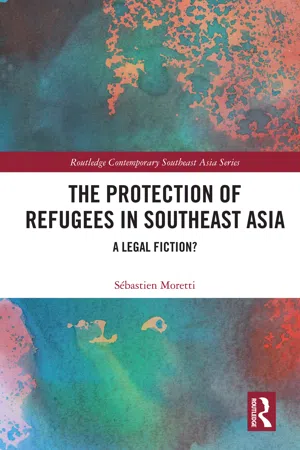
- 244 pages
- English
- ePUB (mobile friendly)
- Available on iOS & Android
About This Book
This book offers a comprehensive and detailed analysis of refugee protection in Southeast Asia from an international law perspective. It examines both the legal and policy frameworks pertaining to the protection of refugees in the region as well as the countries' response to refugee movements from the Indochinese refugee crisis in the mid-1970s to the most recent developments. It covers important aspects of refugee protection, such as access to territory, non-refoulement, the treatment of refugees, the concept of refugee as applied in the region, burden-sharing and durable solutions to the plight of refugees.
The analysis focuses specifically on the main countries of asylum within the Association of Southeast Asian Nations that are not parties to the 1951 Refugee Convention, namely Thailand, Malaysia and Indonesia. Using an international law perspective based on the doctrine of the 'two elements' (practice and opinio juris ), the author argues that these states have long recognized that people fleeing persecution, armed conflict and generalized violence, namely refugees, should be protected. This in turn demonstrates that they recognize the existence and relevance of the international refugee regime despite their refusal to accede to the Refugee Convention.
Offering a different perspective on the links between international refugee law and refugee protection in Southeast Asia, this book will be of interest to researchers and practitioners in the fields of international relations, international refugee law, international human rights law, migration governance and Southeast Asian Studies.
Frequently asked questions
Information
1 Introduction
1.1. An historical overview of refugee movements within Southeast Asia
Table of contents
- Cover Page
- Half Title Page
- Series Page
- Title Page
- Copyright Page
- Contents Page
- Foreword Page
- Preface Page
- List of cases Page
- List of international, regional and national instruments Page
- List of abbreviations Page
- 1 Introduction
- 2 Explaining Southeast Asian resistance to the ratification of the 1951 Convention
- 3 A ‘legal limbo’? Overhauling the normative framework for the protection of refugees in Southeast Asia
- 4 Access to protection
- 5 The refugee concept in Southeast Asia
- 6 The treatment of refugees in Southeast Asia
- 7 The search for solutions
- 8 Conclusion: reconciling Southeast Asia with international refugee law
- Annex: overview of the ratifications by Southeast Asian States of the main international human rights instruments
- Index